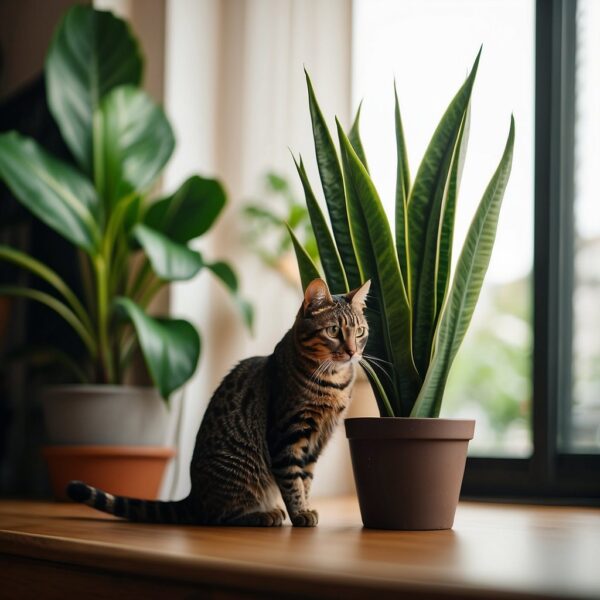
Are Snake Plants Safe for Cats: Unveiling the Facts
Snake plants, also known as Sansevieria or Mother-in-Law’s Tongue, have become a common household plant due to their hardy nature and aesthetic appeal. However cat parents should exercise caution. Snake plants are not safe for cats. Despite the plant’s benefits, it is important to be aware that snake plants are indeed toxic to cats. Ingesting parts of the plant can lead to various health issues in felines.
The toxins present in snake plants are primarily saponins, which can cause nausea, vomiting, and diarrhea if ingested by cats. While the plant’s bitterness usually deters cats from consuming large amounts, even a small amount can cause discomfort. Thus, cat parents should be aware of the potential risks and consider the safety of their pets when introducing new plants into their homes.
Key Takeaways
- Snake plants are toxic to cats due to saponins, which can cause gastrointestinal upset.
- Ingestion of snake plants can lead to symptoms such as vomiting and diarrhea in cats.
- It’s important to consider cat safety when bringing new plants like snake plants into cat-inhabited homes.
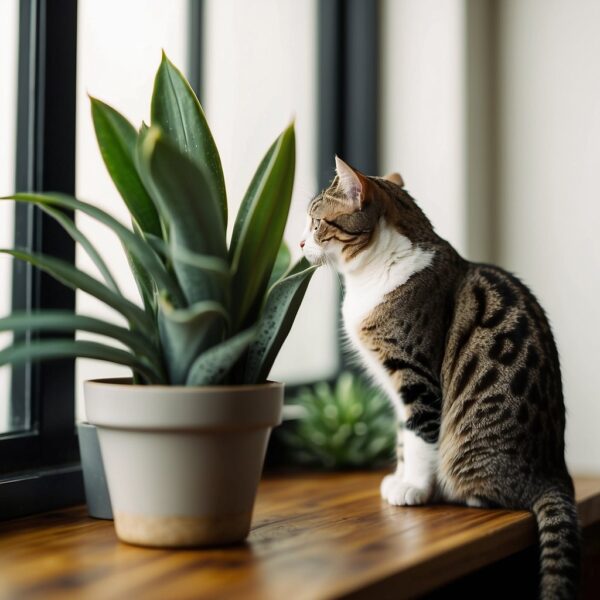
Safety Overview of Snake Plants for Cats
When considering houseplants that may impact the health of cats, it’s essential to understand the toxicity of certain plants and identify those that are safe. This section provides an overview of the safety concerns regarding snake plants and cats.
Toxicity of Snake Plants
Snake plants (Dracaena trifasciata, formerly known as Sansevieria), commonly referred to as mother-in-law’s tongue, contain saponins. These organic compounds can cause nausea, vomiting, and diarrhea in cats if ingested. The severity of symptoms typically varies depending on the amount consumed.
Common Toxic Species for Cats
Apart from snake plants, other common toxic species for cats include lilies and peace lilies. These plants can cause severe reactions and, in some cases, can be fatal. Cat parents should avoid these plants and consult with a vet for a comprehensive list of toxic species.
Safer Houseplant Alternatives
For those seeking safer alternatives, the following are generally recognized as non-toxic to cats:
- Spider plants
- Boston ferns
- Orchids
- Cat grass
- Parlor palm
These plants can be kept at home without the same level of concern as with snake plants.
Identifying Non-Toxic Plants
Identification of non-toxic plants can often be done by consulting reputable sources such as the ASPCA website, which provides a detailed list of plants that are safe for pets.
Importance of Plant Identification
Understanding and identifying houseplants is crucial for preventing accidental ingestion of toxic plants by cats. Cat parents should ensure that all plants within the cat’s environment are properly identified and deemed safe.
Part of the Dracaena Family
Snake plants are part of the Dracaena family, which includes other species and varieties. Some Dracaena species may also contain saponins and should be researched before introduction into a household with cats.
Potential for Insect Prevention
While there’s potential for plants like snake plants to prevent insects due to their saponins, this benefit does not outweigh the risk they pose to cats when ingested. It’s advisable that cat parents prioritize the safety of their cats over these secondary benefits.
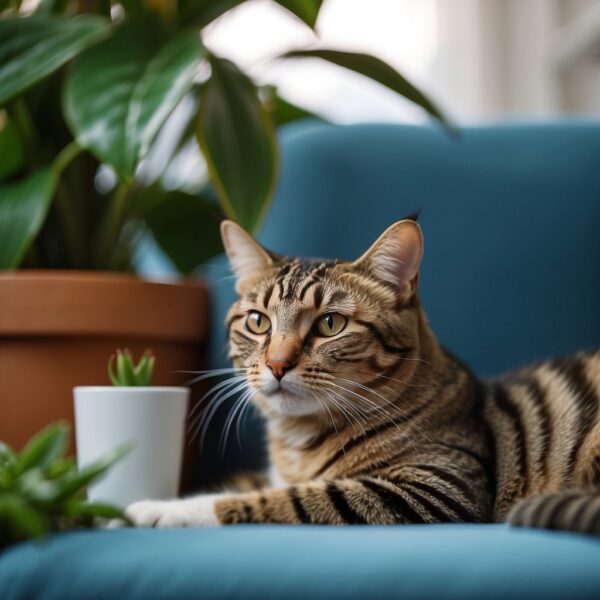
Clinical Signs of Snake Plant Poisoning
When cats chew on or ingest parts of the snake plant, a variety of symptoms can manifest due to the saponins contained in the plant. It is important for cat parents to recognize these symptoms quickly to provide appropriate care.
Recognizing Early Symptoms
Early signs of snake plant toxicity in cats include drooling, nausea, and lethargy. If a cat is observed chewing on a snake plant, parents should be alert for these symptoms as they can develop soon after ingestion.
Gastrointestinal Issues in Cats
The gastrointestinal tract can be severely affected due to snake plant toxicity. Symptoms such as vomiting, diarrhea, and loss of appetite may occur as the saponins cause gastrointestinal irritation and inflammation.
Neurological Reactions
In rare cases, neurological symptoms like tremors, difficulty swallowing, and dilated pupils can present in cats. This reflects more severe toxin exposure and requires immediate veterinary attention.
When to Seek Veterinary Care
Veterinary care should be sought when a cat exhibits persistent or severe symptoms such as prolonged vomiting or diarrhea, which can lead to dehydration. Parents must share the cat’s medical history and any observed abnormalities with the vet.
Managing Acute Cases
In acute cases of poisoning, supportive measures such as fluid therapy may be required to manage dehydration. Vomiting or diarrhea should be closely monitored by a veterinarian to prevent complications like collapse or hemolysis.
Long-Term Health Effects
While most cats recover with proper care, ongoing exposure to snake plant toxins can cause chronic health issues such as kidney failure. Ensuring a cat-friendly environment free of toxic plants is key to long-term health.
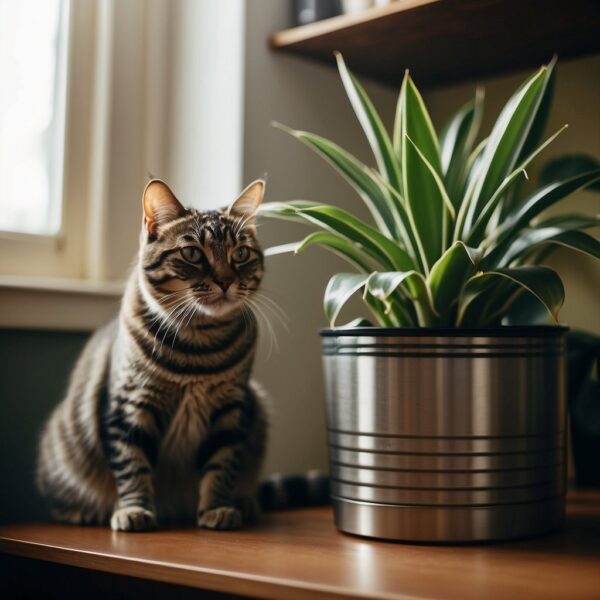
Prevention and Cat Safety
Ensuring the safety of cats in a household with snake plants requires proactive measures. The goal is to prevent ingestion, which can lead to symptoms such as diarrhea and vomiting due the toxic saponins found in the plant.
Strategies for Plant Placement
Elevated Surfaces: Place snake plants on high shelves or ledges out of the reach of cats.
- Windowsills or tall furniture can be ideal locations.
Enclosed Spaces: Consider keeping snake plants in rooms that cats do not have access to.
- Screened-in porches or offices can serve as a separation zone.
Training Cats to Avoid Snake Plants
Taste Deterrents: Apply safe, bitter-tasting substances to the leaves to discourage cats from nibbling.
- Non-toxic, cat-specific deterrent sprays are available at pet stores.
Positive Reinforcement: Redirect cats towards cat-safe alternatives and reward them for choosing those options.
- Catnip and cat grass are suitable and appealing substitutes.
Securing the Home Environment
Routine Inspection: Regularly check houseplants for signs of tampering or ingestion by pets.
- Look for bitten leaves or disturbed soil as indicators.
Air Quality: Maintain good indoor air quality by ensuring adequate ventilation.
- Snake plants improve indoor air by filtering certain airborne allergens but may not be safe for direct contact with pets.
Emergency Preparedness
Emergency Contacts: Keep contact information for the nearest veterinarian and the Pet Poison Helpline readily available.
- Having the number for a 24/7 emergency vet clinic is crucial.
First Aid Knowledge: Familiarize yourself with the basic steps to take if ingestion occurs.
- Do not induce vomiting or administer medication without the guidance of a veterinarian.
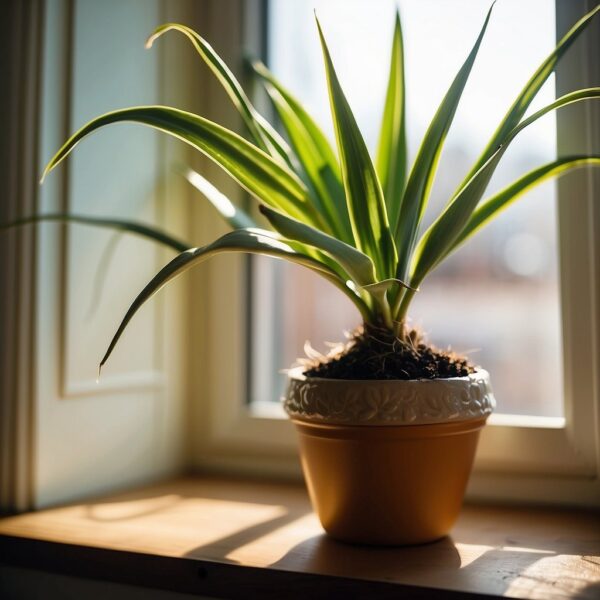
Frequently Asked Questions
The safety of snake plants in homes with cats is a concern due to their toxic saponins. This FAQ section addresses specific risks and preventive measures to keep feline companions safe.
What are the potential risks of snake plants to cats?
Snake plants contain compounds known as saponins, which can be toxic to cats if ingested. These saponins can lead to nausea, vomiting, and diarrhea.
What symptoms should I look for if my cat has ingested part of a snake plant?
Symptoms of snake plant ingestion in cats include drooling, appetite loss, vomiting, diarrhea, and in some cases, abdominal pain. Monitoring for these signs is crucial.
Can snake plants cause serious illness in cats when they are exposed?
Yes, if a cat consumes a large portion of a snake plant, it can experience more severe symptoms such as lethargy or an increase in the severity of gastrointestinal discomfort.
How can I keep my cat safe around snake plants in the home?
To keep cats safe, it’s advisable to place snake plants out of their reach or in areas where cats do not have access. Alternatively, cat parents can opt for pet-safe houseplants.
Are there any non-toxic plant alternatives to snake plants for cat owners?
Cat parents can consider non-toxic plants such as spider plants, bamboo palm, or Boston ferns as safer alternatives to snake plants.
What measures should be taken if a cat ingests a snake plant?
If ingestion occurs, one should immediately contact a veterinarian or a pet poison hotline. Providing details about the quantity ingested and monitoring the cat closely until professional help is obtained is essential.